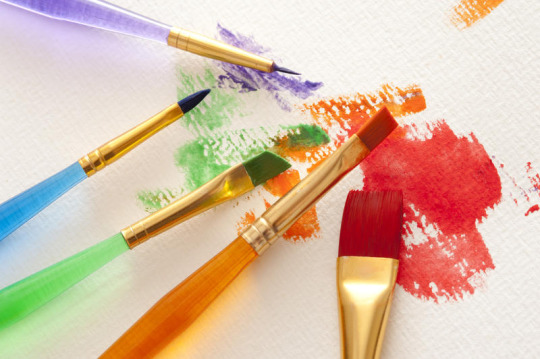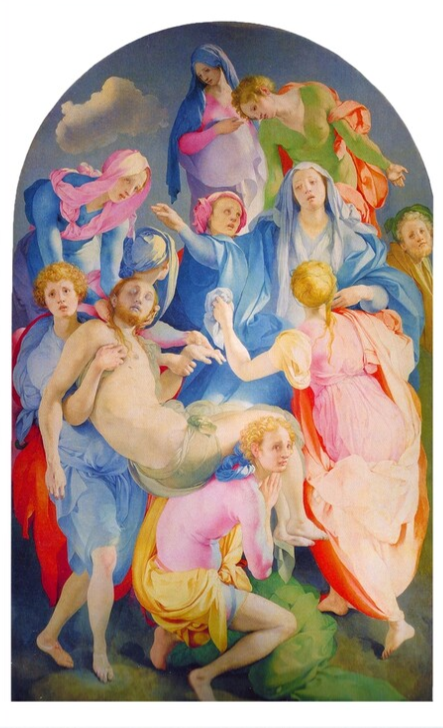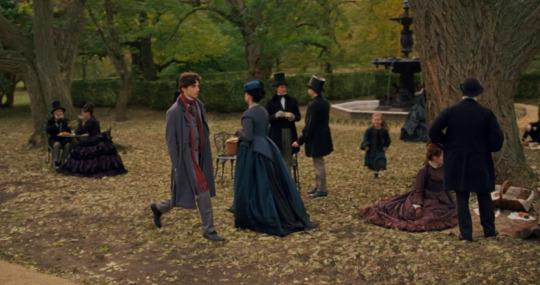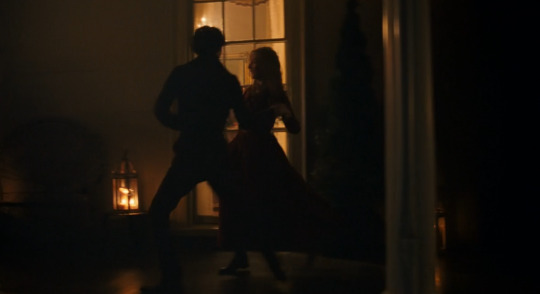Don't wanna be here? Send us removal request.
Text
Let's Not Limit Artistic Creativity, Let's Cultivate It.


I've heard the phrase “you need to be able to get by without technology” quite a bit from my parents, teachers, and peers, but what does it mean to just simply “get by” if we have technology at our fingertips? We are currently in a digital age, so yes technology is involved in almost every aspect of people’s lives. There is no need to shy away from the openness that it offers us. There was a time when machines in factories were modern-day technology and today, we can’t even fathom the idea of navigating by a physical map, we openly embrace the technology. Digital technology should be no different.
Most people find it is easier to imagine children using paints for the first time or clay than technology as a medium for art making. Why is it so stigmatized that a computer or iPad in the hands of a child is deemed unacceptable? I think the answer to that question has to do with how technology is being approached in education. We need to change the way we look at learning as a whole, and technology plays a key role in that. Resnick (2017) states, “if the goal is creative thinking, then step-by-step instructions should be a stepping stone, not a final destination” (p. 45).


In my Learning and Digital Media class at Texas State University, we focused on material inquiries-- learning through hands-on exploration rather than step-by-step instructions. At first, this went over my head. It wasn’t until my second project using Scratch animations that it clicked. I was frustrated; I couldn’t make anything move the way I imagined. My sprites glitched, my loops failed, and nothing synced.
youtube
I started asking my classmates about their discoveries; we shared ideas. I began gaining valuable skills, like creating sprites, coding movements, and building a narrative. This experience showed me that real learning comes through trial and error, embracing mistakes, and collaborating.
Completing my animation boosted my confidence, even though the result wasn’t perfect. I realized, as Hamilton (2010) says, “every act of making matters—how we make matters” (p. 94). The process was the evidence of my growth.
(my complete animation is linked below)
Each student kept detailed notes in the script so our professor could see our minds reevaluating, adjusting, and tackling new problems. That is learning! Being able to gain new skills and apply them to other situations, being engrossed in the material you’re working with and wanting to know more.

What surprised me was that, as young adults, we experienced real learning milestones usually associated with children. These are harder to reach with familiar materials like paints or pencils. Boyle et al. (2014) explains: “When innovation is reframed as finding something new in something known...” (p. 63). That’s exactly what happened to me with Scratch.

This is where technology becomes powerful in education. When it comes to learning to make art with a computer, art teachers are able to cultivate key learning experiences for development in new ways, like introducing acceptance of mistakes, losing perfectionism, and collaboration. Many children have used a marker or a crayon, but what about something they have zero knowledge of like a computer?
youtube
These tools can give them experiences that enhance their creative thinking and critical thinking skills. Resnick emphasizes the "need to help children develop as creative thinkers, so that they’re constantly imagining new possibilities, trying out new ideas, testing the boundaries — and learning in the process” (2017).
If the instructions for the Scratch assignment had been super strict and my professor had told us exactly how to move a sprite or loop its sequence, none of us would have gained anything from the inquiry. This approach is the same with children. They need an open structure of freedom with guidance. This reflects Resnick’s (2017) concept of “low floors and high ceilings” (p. 12).
I learned pivot quickly. If I pressed the green flag and my animation and a sprite sped in the wrong direction, I would tweak my sequences then try again. This trial and error became methodical: see a problem, try to fix it. I wasn't afraid of making mistakes because I knew I could adjust. Many children are so afraid of mistakes and making their work “perfect” that they miss the whole point of just creating and they miss out on chances to challenge themselves in new ways.

(Above is art I made with photoshop in my college CORE class, my first time using digital application to make art within an educational setting.)
While reading Resnick’s, Lifelong Kindergarten and taking class with Dr. Sean Justice, I realized that art education shouldn’t be restricted to a pen and paper. Art has no limits—and neither should we. As teachers, peers, and parents, we must commit to cultivating creativity and embracing new technologies in this era of digital possibility.
Citations
Resnick, M. (2017). Lifelong kindergarten: Cultivating creativity through projects, passion, peers, and play. MIT Press.
Hamilton, A. (2016). Making, not knowing: In the making. In P. Hickman (Ed.), Art encounters: Teaching, learning and research (pp. 91-101). Open University Press.
Boyle, S., Gray, J., & Malley, S. (2014). Thinking, not stuff. In C. Donohue (Ed.), Technology and digital media in the early years: Tools for teaching and learning (pp. 61-72). Routledge.
#art education#digital media#creative thinking#children#teaching#learning#education#technology#Youtube
0 notes
Text
Blog Post #6: My Signage Story
While taking these photos I wanted to capture the narrative of being a young college student. There is a sense of youthful energy to the signage that I specifically wanted to shine through with bright colors and unique fonts around my university. I picked these five pictures in the end to create a nostalgic feeling of staying up late, young love, finding your people in a new, unexpected environment, and simply soaking up the freedom and growth away from home. As a current student at university, I wanted to be able to express the environment that is slowly becoming like a second home to me by only using words around me.





0 notes
Text
Blog Post #5: Composition Study
Part 1: The Four-Square Exercise

^(Thematic words: order, increase, bold, congested, tension, and playful)

^(Thematic words: anxious, naive, fragile, narrow, united, famous)
Part 2: Artwork Analysis

Jacopo da Pontormo's Deposition was created during the Italian High Renaissance, he depicts the carrying of Jesus from the cross. Highly inspired by Leonardo Da Vinci-- who he studied under-- and Michelangelo’s Sistine Chapel, Pontormo uses highly complex poses, distinctive tertiary colors, and a busy composition with many figures to highlight his talent in comparison to the notable greats. The lack of the literal cross and the use of this recognizable narrative insists that Pontormo’s focused more on proving his technical skills as opposed to retelling the deposition of Christ. This is heavily reflected in his compositional choices. There is little negative space due to the artist's dynamic figures, each figure is deliberately in tight fitting clothing emphasizing Pontormo's knowledge of anatomy, and the colors are stylized.
Since all the figures are compacted in such a small frame, I would consider this piece a closed circular composition due to my eye being drawn inside of the frame. In addition, their overlapping bodies cause a sense of depth and movement almost as if the audience is catching a glimpse into the sacred narrative. While there is not a literal representation of the cross, there is an implied cross as the vertical figures intersect the horizon line. Compositionally, this piece is compelling to look at due to the curved frame and the figures who follow that radial path with their poses as well as their positions on the canvas to keep the viewer engaged.
0 notes
Text
Blog Post #4: Film Color Study, Little Women

While in Paris with her aunt, Amy March is wearing baby blue in stark contrast to her grandmother who is in a deep, plum. The baby blue symbolizes Amy’s youth as well as her vigor for learning in Paris, while Aunt March is depicted as old and more content to ride in the carriage through the park. This is reinforced by Amy’s outburst of joy when she sees Laurie in the park, as Aunt March disapproves of the impropriety.

Laurie’s red scarf catches the eye of the audience by having a vivid red hue. It pulls not only Amy March’s eye when she is riding in the carriage, but helps the viewer track him while the camera pans quickly. Though simply practical, it is highly effective.

Beth March’s dress is a dull brown, matching the interior of the empty, dark March house now lacking the chaos and overwhelming love of the rest of the sisters. This evokes an isolated mood as well as symbolizing Beth being tied to the house itself, foreshadowing her sickness and later her death. Her whole life revolves around their home; she is their home.

Jo March and Laurie leave the ball to dance outside. The warm light from within the party causes them to become dramatic silhouettes which emphasizes their outsideness from not only from the rest of the party, but from society. They challenge the societal social norms by acting silly and improper. This also mirrors Jo’s attitude towards her obligations as a woman and Laurie’s obligations as a rich, young man entering society: rebellious.

The Lawrence house establishes a lonely, bleak atmosphere with the deep browns and lack of bright lighting or vibrant colors which is in huge contrast to the March house, which is vibrant, lively and full of chaos. Though the Lawrence house is full of wealth and knowledge, they lack the warmth and all-consuming affection that the March women have.

The ball in Paris, where Amy March approaches a drunk Laurie, is full of black dresses and suits which follows a few scenes after the ball in the past where Laurie and Jo danced outside. This reflects the jump from childhood to adulthood that Laurie and Amy have experienced. They are no longer children playing characters in Jo’s plays, they are in society with real-life consequences.
8 notes
·
View notes
Text
Eadweard Muybridge, Zoopraxographer (1975) is a film essay by Thom Andersen
While watching this film I found it painstakingly long, but I did find some value in Muybridge’s legacy on photography, cinema, and the task of documentation within history. His many shocking series of naked figures partaking in motions range from ordinary to startling. They aimed to challenge the human perception of beauty and right from wrong. Today, we are quite desensitized to sexuality and scenes depicting the unclothed body, but Muybridge experimented with more than just that in an era where even the thought was obscene and crude. His series emphasized the human condition using a lack of perfection or pretty angles. Our obsession with how we present ourselves to the people around us has only increased due to the media and new technologies, and though Muybridge was an insane, dare I say intensely creepy, guy he was transparent about his intentions to photograph his models in harsh lighting and humiliating conditions.
His images, in quick succession, created the first motion-picture film which is a highly incredible legacy to leave; leading to the world of cinema and opening a door for a new artform: film. Although, when I finished watching this documentary on Muybridge, I found myself questioning the historical significance of his works. Yes, I can appreciate the cultural significance of desensitizing audiences by juxtaposing the naturalness of the figure’s movements with their unnatural nakedness, but does his legacy boil down to film as art? It wouldn’t be a bad legacy to leave, but I can’t help but wonder if I appreciate his works because of how radical they were at the time or because I appreciate the influence he left on contemporary film today. Either way, he opened people’s minds when it comes to how people are perceived, documented the human condition (which he staged himself, so not completely authentic), and gave us a better understanding of movement as a form of expression.
0 notes
Text
The connection between people and cameras in the 2020s
Susan Sontag, In Plato’s Cave from the book: On Photography
While reading In Plato’s Cave from Susan Sontag's book On Photography I was completely blown away by the complexity of her thoughts on photography as well as how elegantly beautiful her words were. Sontag said, “to collect photographs is to collect the world” I read this over and over because it feels like she hit her mark. Today every single day I take at least one photograph, if not plenty more. Our connection to capturing the moment is so powerful that we can’t even stop ourselves from saying, “wait let me get my phone” or “I need to take a picture of this” this almost physical need to immortalize a moment or experience. This train of thought had me thinking about what makes photography an art. If we take so many pictures every day, what makes picture art? Sontag even said herself that “Photography is not practiced by most people as an art.” Then I realized as I continued reading that if a picture can memorialize, convict, persuade, manipulate, shock, or express anything to a viewer, that is what makes it an art. Travel, ancestry, politics, love, war, time, space, fun. The list of why we take pictures is infinite.
We are in the 21st century, yet we are the same as every person who has ever deigned to take a picture of a beautiful, rolling landscape, of the crowds of people walking on the streets of Times Square, of a bride and grooms first dance, or of a five-year-old daughter opening presents on Christmas morning. Cameras solidify reality, possibly detaching us from an overwhelming wave of emotion or conceptualizing our deliberate intent but forever transforming a moment into an object that occupies a place in time. Photography is legacy, nostalgia, intimate, personal, aggressive, powerful, erotic and beyond these definitions. It is complex and hard to define at the same time. I will end my thoughts on a final quote from Sontag that completely broke me “to photograph people is to violate them, by seeing them as they never see themselves, by having knowledge of them they can never have: it turns people into objects that can be symbolically possessed.”
1 note
·
View note
Text
HyperNormalisation by: Adam Curtis
When watching this documentary by Adam Curtis, it made me reconsider film as a form of art. When it comes to documentaries in general, they act as an archive. I've never thought about that until now. The collection of video clips, interviews, and graphic scenes are all tools to time stamp a certain period in history, in this case the year 2016. The documentary focuses on a certain point of view that is expressed by using dramatic filming techniques like slow pans of the cityscape or using the simple cinematography of a person typing on a computer, an empty room, even blood stains. These all seem very random, but Adam Cutis uses them deliberately to evoke a wide range of emotion within his audiences.
Curtis never uses a clip of video for too long and cuts to the next in a quick, yet sometimes shocking way. I would say that he does this to highlight the ever-changing world that we live in today as well as emphasize how the dark and gruesome get overlooked, normalized, hence his title. The medium of film has a wide range of ways to express his message, yet Curtis uses similar techniques consistently in the documentary with his narration, old footage, and dramatic music. The combination of all these elements contribute to this film’s impact not only for the time it is reflecting on-- 2016, but also for today--2025, there are similarities to the present day that are scarily accurate. This archival documentary seems to reveal our continued mistakes within the ever-changing, yet always relevant, cultural and political climates.
I feel that this film was very strong with its message and overall impact, but I truly did find it a bit monotonous at times. HyperNormalisation made me feel like my eyes were opened a bit wider to the world that is before me, a little sad, anxious and honestly like we are reliving history a bit. It makes me wonder how art can be incorporated into archives and whether or not documentaries also act as a form of art. In a sense everything is art, but how can random objects, photos, videos, etc. go from being just that to being an archive that has meaning? What makes the archive cohesive and how does one go about that process?
4 notes
·
View notes